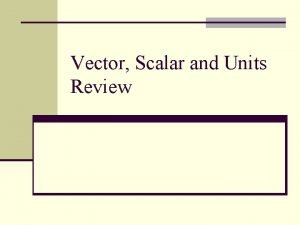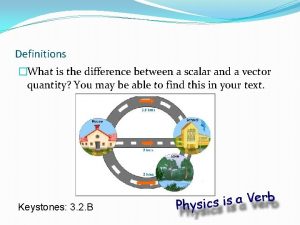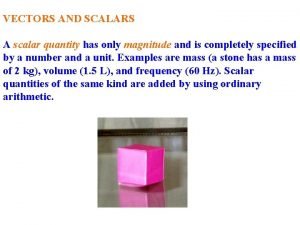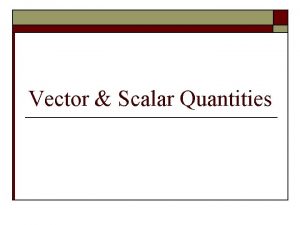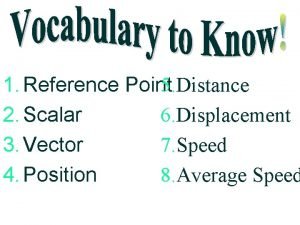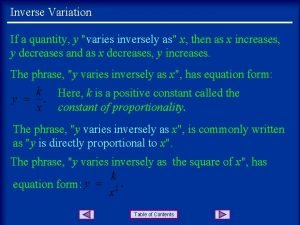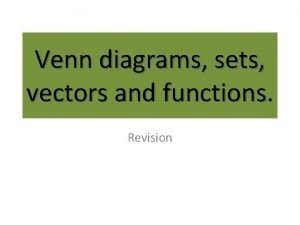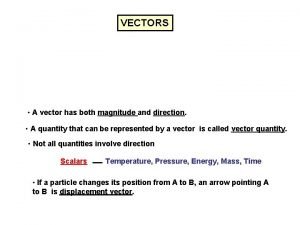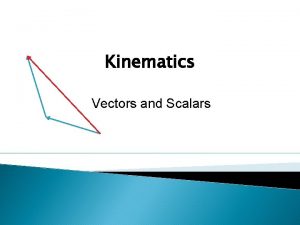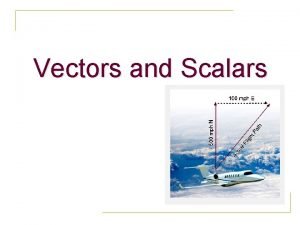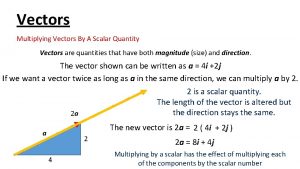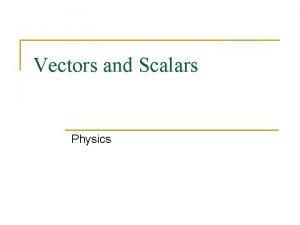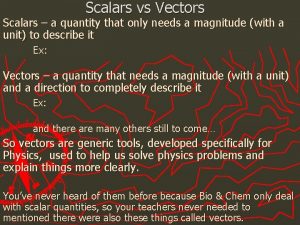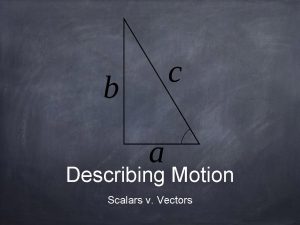Vectors and Scalars A SCALAR is ANY quantity































- Slides: 31

Vectors and Scalars


A SCALAR is ANY quantity in physics that has MAGNITUDE, but NO direction. Scalar Example Magnitude Speed 20 m/s Distance 10 m Age 15 years Heat 1000 calories Number of horses behind the school 0 (now)

Vector Magnitude & A VECTOR is ANY Direction quantity in physics Displacement 5 m, NW that has BOTH Velocity 20 m/s, N MAGNITUDE and Acceleration 10 m/s/s, E DIRECTION. Force 5 N, West Vectors are typically illustrated by drawing an How are velocity and speed related? ARROW above the symbol. The arrow is used Speed is a scalar – it just has magnitude. to convey direction and magnitude. Velocity has both magnitude and direction. Example: 20 m/s = speed V 20 m/s NE = velocity

Vector Magnitude & A VECTOR is ANY Direction quantity in physics Displacement 5 m, NW that has BOTH Velocity 20 m/s, N MAGNITUDE and Acceleration 10 m/s/s, E DIRECTION. Force 5 N, West Any guesses as to what displacement is? Vectors are typically illustrated by drawing an (Hint, look at the units!) ARROW above the symbol. The arrow is used to convey direction and magnitude. Displacement is the vector quantity of distance … that is, it tells how far and in what direction two things are located.

How to draw vectors The length of the vector, drawn to scale, indicates the magnitude of the vector quantity. the direction of a vector is the counterclockwise angle of rotation which that vector makes with due East or x-axis.

How to draw vectors – lady bug displacement NOTE 1: displacement x = 6 cm, 250 length = magnitude 6 cm 250 above x-axis = direction Displacement shows how far apart something is now compared to from where it started. It does not show the path or the total distance travelled. NOTE 2: x 250 Tail H LHead When drawing a vector you MUST put a ‘head’ or arrow on the vector to demonstrate which direction it is pointing.

QUICK REVIEW What is the difference between a scalar and a vector? What are the parts of a vector?

QUICK REVIEW What is the difference between a scalar and a vector? Scalars have magnitude only, vectors have magnitude and direction. What are the parts of a vector? tail head

A resultant (the real one) velocity is sometimes the result of combining two or more velocities.

Adding Vectors – Plane example 1 (tailwind) A small plane is heading south at speed of 200 km/h (This is what the plane is doing relative to the air around it) To understand how far the plane is traveling relative to the ground we need to add the two vectors – the plane’s heading and the tailwind. 1. The plane encounters a tailwind of 80 km/h. 20 kmh 80 kmh 0 e We add vectors by moving them head to tail and finding the resultant (sum). 20 km h 0 28 0 80 km/ h km h The resulting velocity relative to the ground is 280 km/h S

Adding Vectors – Plane example 2 (headwind) A small plane is heading south at speed of 200 km/h (This is what the plane is doing relative to the air around it) 2. It’s Texas: the wind changes direction suddenly 1800. Now the plane encounters a 80 km/h headwind Move the vectors head-totail and find the resultant vector. 80 km h 20 kmh 0 How do we figure out the plane’s velocity relative to the ground? e 12 km h 0 The resultant vector always goes from the tail of the first vector to the head of the second vector The resultant velocity is only 120 km/h south. .

Adding or subtracting vectors in a straight line is easy, but what if the wind is coming from the side? We need to use trigonometry.

3. The plane encounters a crosswind of 80 km/h. 80 km h 20 kmh 0 Will the crosswind speed up the plane, slow it down, or have no effect? How can we find out? As in the other two examples, we have to add two velocity vectors head-to-tail in order to find the resultant vector. How can we calculate the magnitude of the resultant vector? 80 kmh 20 kmh 0 Use trigonometry! Specifically, Pythagorean theorem. RESULTANT VECTOR (RESULTANT VELOCITY) v = 215 km/h SE How can I find the exact angle? Use trig! Specifically, tan-1. So the plane is traveling F = tan-1 (80 / 200) = 215 km/h at 22 o E of S. 22 o

20 kmh 0 28 kmh 0 12 kmh 0 21 kmh 5 18 kmh 0 So why do we use vectors in physics? ? ? Because direction matters!

The order in which two or more vectors are added does not effect result. vectors can be moved around as long as their length (magnitude) and direction are not changed. Vectors that have the same magnitude and the same direction are the same. Adding A + B + C + D + E yields the same result as adding C + B + A + D + E or D + E + A + B + C.

Quick check: Are all these vectors equal or not? How do you know? Yes! They are all equal. A vector quantity is determined by its length and direction. Its position doesn’t matter. That’s why we can move vectors around to add them.

n Example: A man walks 54. 5 meters east, then 30 meters west. Calculate his displacement relative to where he started. 54. 5 m, E 24. 5 m, E n 30 m, W Example: A man walks 54. 5 meters east, then again 30 meters east. Calculate his displacement relative to where he started. 54. 5 m, E 30 m, E 84. 5 m, E n Example: A man walks 54. 5 meters east, then 30 meters north. Calculate his displacement relative to where he started. 62. 2 m, NE 54. 5 m, E 30 m, N

BUT…. . what about the VALUE of the angle? ? ? Just putting North of East on the answer is NOT specific enough for the direction. We MUST find the VALUE of the angle. 62. 2 m, NE 30 m, N = 290 54. 5 m, E So the COMPLETE final answer is : 62. 2 m, 290 or 62. 2 m @ 290

Try the following on your own n A person walks 5 m N then walks 8 m S. Calculate their displacement. n A ball is thrown 25 m/s E. A tailwind of 5 m/s E is blowing. Calculate the resulting velocity. n A boat moves with a velocity of 15 m/s, N in a river which flows with a velocity of 8. 0 m/s, west. Calculate the boat's resultant velocity with respect to due north

Try the following on your own. n A person walks 5 m N then walks 8 m S. Calculate their displacement. 5 m 8 m 3 m South 3 m n A ball is thrown 25 m/s E. A tailwind of 5 m/s E is blowing. Calculate the resulting velocity. 30 m 25 m 30 m East 5 m

A boat moves with a velocity of 15 m/s, N in a river which flows with a velocity of 8. 0 m/s, west. Calculate the boat's resultant velocity with respect to due north. 8. 0 m/s, W q 15 m/s, N The Final Answer :

Example A bear, searching for food wanders 35 meters east then 20 meters north. Frustrated, he wanders another 12 meters west then 6 meters south. Calculate the bear's displacement. 12 m, W 6 m, S 20 m, N R 35 m, E 23 m The Final Answer: 14 m

IMPORTANT NOTE: The Pythagorean theorem and trig functions can only be used for right angle triangles! Later, I will teach you how to handle vectors that meet at angles other than right angles.

Multiplying vector by a scalar Multiplying a vector by a scalar will ONLY CHANGE its magnitude – not direction. One exception: Multiplying a vector by “ -1” does not change the magnitude, but it does reverse it's direction A 2 A 3 A ½ A Opposite vectors A – A - A – 3 A

Vector Components Any vector can be “resolved” into two component vectors. A Ay Ax Ax is the horizontal component – or x component -- of the vector. Ay is the vertical component – or the y component – of the vector.

Example: A plane heads east, while the wind moves a plane north. As a result, the plane moves with velocity of 34 m/s @ 48°relative to the ground. Calculate the plane's heading and wind velocity. What does this mean? ? It means we need to find the x-component of the plane’s resulting velocity (= wind velocity) and the y-component of the plane’s resulting velocity (= plane’s heading). v = 34 m/s @ 48°. Find vx and vy vx vy

A plane moves with a velocity of 63. 5 m/s at 32 degrees South of East. Calculate the plane's horizontal and vertical velocity components. vx = ? 320 63. 5 m/s Vy = ?

Problems for you to try individually n A person walks 450 m @ 120 degrees. Find the x and y component vectors. n A car accelerates 6 m/s 2 at 40 degrees. Find the x and y component vectors.

Problems for you to try individually A person walks 450 m @ 120 degrees. Find the x and y component vectors. -225 m = Ax 390 m north = Ay n A car accelerates 6 m/s 2 at 40 degrees. Find the x and y component vectors. 5 m = Ax 4 m = Ay n

You can find a vector from its components. This problem may be written differently, but its exactly the same type of problem we did during exactly our first lesson on vectors! Let: Fx = 4 N Just add the components to find the overall Fy = 3 N. vector! Find magnitude and direction of the vector. Fx 2+ Fy 2 = F 2 Fx Fy = arc tan (¾) = 370
 Vector quantities measure
Vector quantities measure Scalar and vector quantities
Scalar and vector quantities Does scalar quantity has magnitude
Does scalar quantity has magnitude Scalar quantity and vector quantity
Scalar quantity and vector quantity A storm system moves 5000 km due east
A storm system moves 5000 km due east Vector in physics
Vector in physics Entropy is scalar or vector
Entropy is scalar or vector Lesson plan on vectors and scalars
Lesson plan on vectors and scalars Multiplying or dividing vectors by scalars results in:
Multiplying or dividing vectors by scalars results in: Power is scalar or vector
Power is scalar or vector Scalar and vector quantity difference
Scalar and vector quantity difference Scalar product of vectors
Scalar product of vectors Scalar quantity has only
Scalar quantity has only Characteristics of vector quantity
Characteristics of vector quantity Is centripetal force a vector quantity
Is centripetal force a vector quantity Displacement formula distance
Displacement formula distance Chapter 1 physical quantities and measurement
Chapter 1 physical quantities and measurement Vary inversly
Vary inversly Prasanna balaprakash
Prasanna balaprakash There is there are
There is there are Any to any connectivity
Any to any connectivity Any question atau any questions
Any question atau any questions Big ed mona multimodal text
Big ed mona multimodal text Scalar vs vector projection
Scalar vs vector projection Dot
Dot Dot product
Dot product Scalar and vector quantization
Scalar and vector quantization Set notation venn diagrams
Set notation venn diagrams Transpose of matrix product
Transpose of matrix product Line segment geometry
Line segment geometry Tan-1(ry/rx)
Tan-1(ry/rx) Vectors have both magnitude and direction
Vectors have both magnitude and direction









